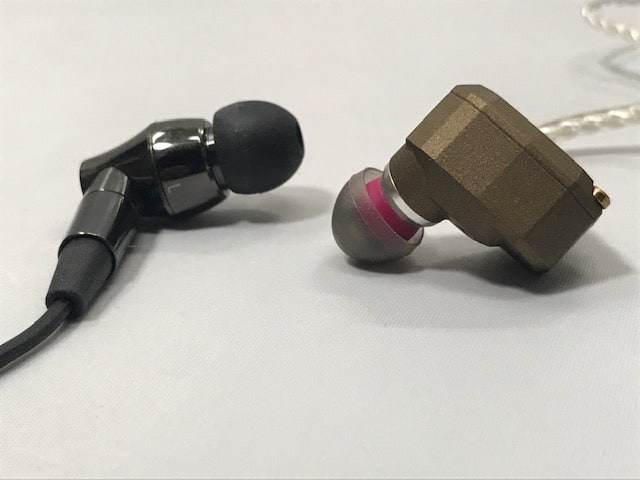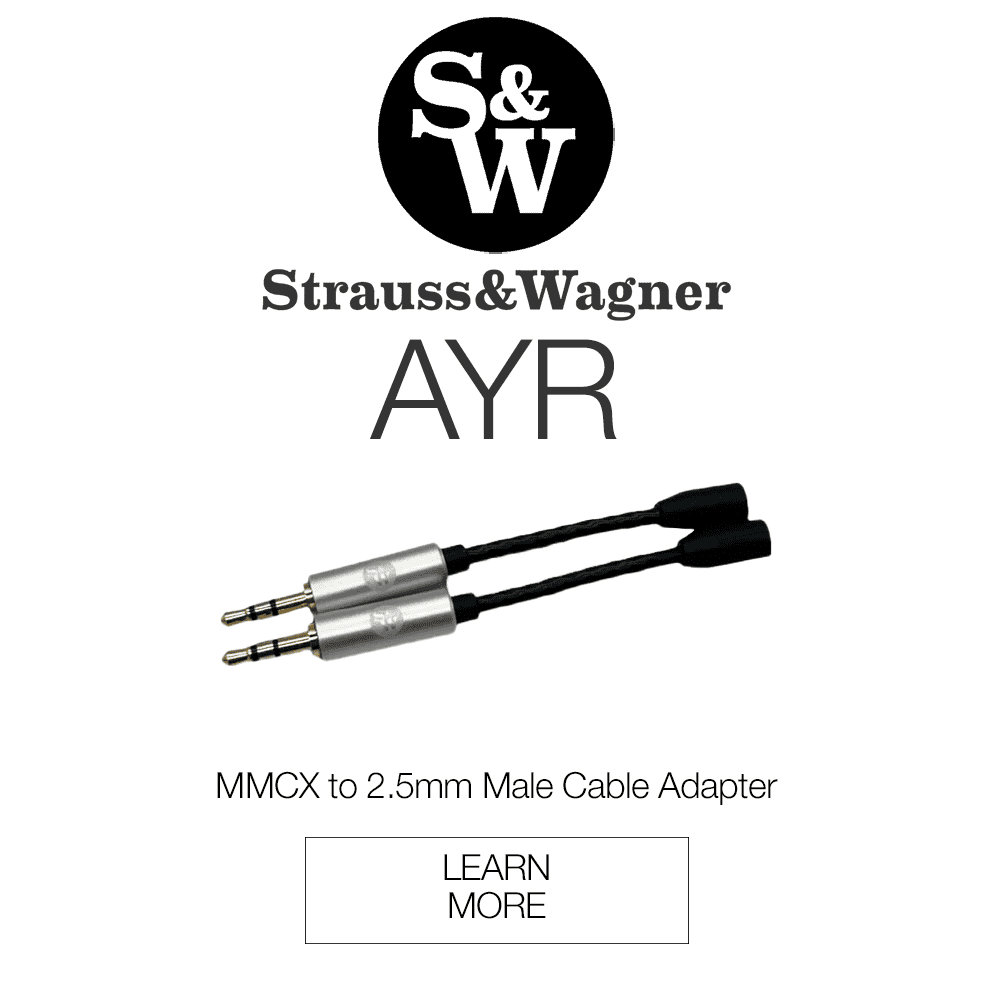The newest high end IEM from Audio Technica, the CK2000Ti sits at an interesting price point. There are many IEMs that go for $1000, and many that go for around $500. However, sitting at $750, this IEM stands alone, with only a few competitors. One of those competitors is from one of my favorite companies, Campfire Audio. The Campfire Audio Jupiter normally sells for $799. How do these two price-siblings compare to each other? Today, I’ll take a closer look with this Audio Technica ATH-CK2000Ti vs Campfire Audio Jupiter Comparison Review.
Audio Technica ATH-CK2000Ti vs Campfire Audio Jupiter Comparison Review
Design – Audio Technica ATH-CK2000Ti vs Campfire Audio Jupiter Comparison Review
Look and Feel
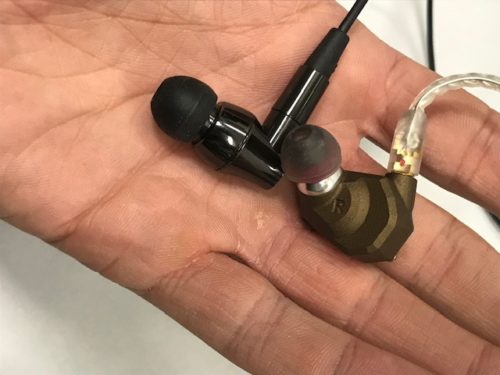
The driver housings of the Audio Technica ATH-CK2000Ti and the Campfire Audio Jupiter have different designs and finishes. The CK2000Ti has a smooth shape and a glossy grey finish on its titanium shell. On the other hand, the Jupiter has more of a mechanical look. It has a matte brown finish made of Cerakote. As a result, both the Audio Technica CK2000Ti and the Campfire Jupiter feel strong and stout in the my hands.
The cable connections feel sturdy, like I’d need to use strength and precision to disconnect them from the earpieces. Additionally, the cable of the CK2000Ti is meant to hang straight down. By contrast, the cable of the Jupiter is meant to hook behind the ear. As a result, the cable attaches to the bottom of the CK2000Ti and the top of the Jupiter.
Fit
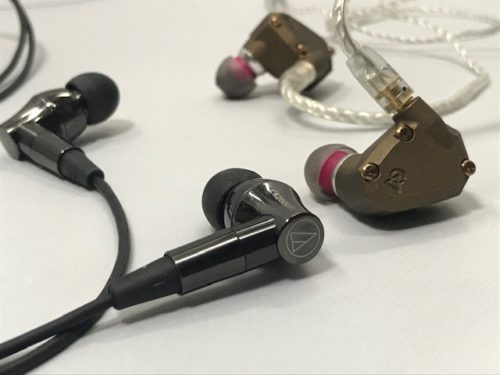
I had good luck fitting both the Audio Technica ATH-CK2000Ti and the Campfire Audio Jupiter in my ears. While they both seemed to fit securely, their fitting styles felt different. On one hand, The ATH-CK2000Ti has a classic in-ear earbud style, fitting straight into the ear canal. On the other hand, the Jupiter has more of an in-ear monitor design. Its nozzle and ear tip protrude from the side of the earpiece, and its cable wraps over top and behind the ear.
The driver housing of the Audio Technica CK2000Ti didn’t touch my earlobe. In fact, its fit depended, it seems, almost entirely on the eartip in the ear canal. That said, with my smallish ears, I had the best luck fitting these earphones with the medium silicone tips. The smallest foam tips seemed larger than normal. They didn’t provide the same seamless comfort as the silicone tips for me.
Conversely, the driver housing of the Campfire Jupiter contributed to the security of its fit in my ear. It rested on the bottom ridge of my earlobe, and balanced nicely by the cable around the top of my ear. When I first placed it in my ear, it was a bit cold. However, once my skin warmed it, it was comfortable. I had the best luck fit-wise with the smallest foam “marshmallow” tips from Campfire Audio and the small Spinfit tips. However, the best seal came from the foam tips. The Campfire silicone tips wanted to slip out. As a result, the listening portion of the review will feature the silicone tips on the CK2000Ti and the silicone Spinfit tips on the Jupiter.
Cables
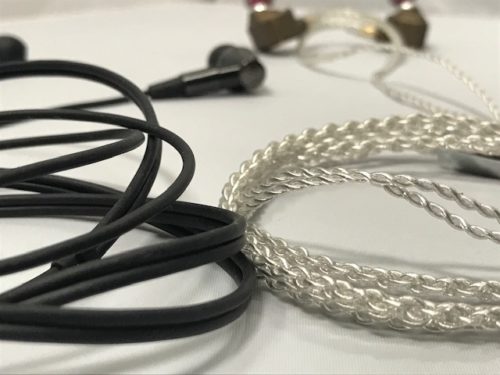
The cables of the Audio Technica ATH-CK2000Ti and the Campfire Audio Jupiter are similar in length and manageability. Neither have the urge to become tangled, and they are all malleable and controllable.
One major difference between the two products is that the Audio Technica CK2000Ti comes with two cables, one balanced and one unbalanced cable. The balanced cable has a 4.4 mm connector. The unbalanced has a 3.5 mm connector. Both cables attach to the earpieces via hefty A2DC connectors. This is somewhat of a downside because there won’t be as many options for mixing and matching cable options, for all you cable nerds out there. Additionally, both cables have sort of a standard, matte black rubber jacket.
On the other hand, the Campfire Jupiter comes with just one unbalanced cable. It has a 3.5 mm connector and connects to the earpieces with standard MMCX connectors. Additionally, the cable is gorgeous. Its clear jackets reveal the four silver coated copper conductors inside. It is pragmatically braided, the benefits of Litz wire manifesting in both look and sound.
Drivers
Beyond the external differences of the Audio Technica ATH-CK2000Ti and the Campfire Audio Jupiter, both earphones contain different types of drivers. On one hand, the Audio Technica CK2000Ti has two dynamic drivers, positioned in a unique, push-pull fashion. In other words, the drivers face each other and are wired 180 degrees out of phase with each other. Audio Technica says this design lowers harmonic distortion, improves damping, and controls bass frequencies better than it would otherwise. Also, the two drivers are different diameters (one is 9.8 mm and the other 8.8 mm). Audio Technica says this helps the high frequency response.
On the other hand, the Campfire Jupiter is equipped with four balanced armature drivers. Two are dedicated to the high frequencies and two are dedicated to the low frequencies. Their crossovers meet in the middle, creating an expansive sound, according to Campfire Audio. These four drivers in combination with Campfire’s patented T.A.E.C. (Tuned Acoustic Expansion Chamber) replaces the traditional tube and dampen system of other IEMs. Instead, it tunes the acoustics without compression. How do these details affect the sound? Let’s take a closer look (ahem, I mean, listen).
Sound – Audio Technica ATH-CK2000Ti vs Campfire Audio Jupiter Comparison Review
Low Frequencies
The low frequencies of the Audio Technica ATH-CK2000Ti are round and warm. They have a bit of a boost right around the fundamental of many kick drums. As a result, kick drums tend to sit a bit louder in the mix than usual. While the lows don’t feel cloudy, they do come through with a sense of warmth, smoothness, and fullness. They’re both aesthetically pleasing and groovy. However, I wouldn’t describe them as neutral or perfectly even.
For example, when I was listening with the CK2000Ti to the song I’m Callin’ by Tennis, the kick drum came through a bit louder in the mix than it normally does. It felt like it took up more space than usual, although I could still clearly hear the bass guitar in the low-mids. The kick’s sound had a sense of punchiness in the middle area of the low frequency range but mostly felt smooth, with a soft pillowiness to its character.
On the other hand, the low frequencies of the Campfire Audio Jupiter are quicker in nature than the CK2000Ti. They emphasize the sub region slightly, but maintain a sense of punchiness and tightness. As a result, the kick, while a bit quieter in the mix level-wise, maintains its emotional and groovy impact. For example, when listening to the same song (I’m Callin by Tennis) the kick drum has ample space to breath and move in between hits with the Jupiter.
Middle Frequencies
The middle frequencies of the Audio Technica ATH-CK2000Ti feel even in the low-mids and midrange. However it does have a pretty hefty boost in the high-mids. As a result, while midrange rich instruments maintain a sense of harmonic complexity and warmth, they lean forward in the soundstage and emphasize attacks. Meanwhile, because of the evenness in the midrange, reverbs and room mics come through clearly. Additionally, vocals tend to sit louder in the mix than usual.
For example, when I was listening to the song Matter of Time by Sharon Jones and the Dap Kings, the guitars, organ, horns, and bass all felt full and complex harmonically. However, the high part of the organ’s leslie, the initial blow of the horns, and the higher notes of the bass and guitar sat forward in the mix. The room microphones of the drums helped give them more length. Additionally, Sharon’s vocal sat louder in the mix than usual. The emphasis of the mids, in fact, seemed to really center on her vocal, providing nuance to her performance, emotionally. As a result, it seems these earphones are best for folks who want their earphone to give extra emphasis to vocals.
On the other hand, the middle frequencies of the Campfire Audio Jupiter, like its low end, sound quicker overall than the CK2000Ti. As a result, most midrange instruments seem to have greater separation from one another. The midrange has a little bit of an emphasis in the low-mids. Additionally, there is a bit of emphasis in the top area of the high-mids. As a result, this targeted high-mid response gives the Jupiter a greater sense of articulation than the CK2000Ti, whereas the CK2000Ti feels smoother and warmer than the Jupiter.
For example, when I was listening to the same song (Matter of Time by Sharon Jones and the Dap Kings), the bass guitar felt a bit louder and tighter in the mix. Additionally, the organ, guitars, bass, and horns and background vocals had greater separation from one another. It was also easier to hear the grace notes in the high-hat and snare performance. Sharon’s voice felt a bit more tucked in, although the emphasis in the top part of the high-mids gave her words a bit of extra articulation.
High Frequencies
The high frequencies of the Audio Technica ATH-CK2000Ti are mostly even. They aren’t particularly boosted relative to the mids and lows. However, there is a cut in the lower treble and boosts in both the upper treble and upper octave relative to the high frequencies as a whole. As a result, high frequency rich instruments like cymbals and strings lean away from their attacks and have more emphasis in their texture, while maintaining their usual level in the mix. These instruments still have a sense of harmonic complexity, but just favor the upper region of the highs.
For example, when I was listening to the song Miles Runs the Voodoo Down by Miles Davis, the the character of the individual cymbals came through clearly. However, the texture of the brushes across them, their highest overtones, as well as the texture of the snares revealed themselves more prominently than usual.
On the other hand, the high frequencies of the Campfire Audio Jupiter are boosted more in general than the CK2000Ti. However, like the it, the Jupiter emphasizes a similar region, favoring the upper treble and upper octave. As a result, high-frequency-rich instruments like cymbals and percussion have an emphasized sense of texture and air that sits higher in the mix than the CK2000Ti and than usual. Additionally, while the high frequencies of the CK2000Ti tend to have a washy, smooth sense to them, the highs of the Jupiter feel quicker and more dynamically active.
For example, when I was listening to the same song (Miles Runs the Voodoo Down by Miles Davis), the cymbals, while full of their usual character seem more active, and thus somehow more delicate than the CK2000Ti. Additionally, they’re a bit louder in the mix. However, their timbres did seem to blend a bit more with the subtle snare rolls.
Soundstage
The soundstage of the Audio Technica ATH-CK2000Ti has a overlying sense of smoothness to it. This smoothness feels less like a sense of ambiguity, and more like an aesthetic choice on Audio Technica’s end. The most dramatic part of the soundstage is the sense of height. The tallness of high-frequency-rich instruments contrasts clearly from the sense of solidity of the low instruments down in the chest. And while the sense of width and depth feel less specific, the fullness of the midrange reveals room mics richly. As a result, mixes that emphasize the sense of depth using room mics come through with a sense of distance. However, be aware that the high-mid emphasis brings instruments that land in the high-mids a bit closer in space.
For example, when I was listening with the CK2000Ti to the song Fever by Ray Charles featuring Natalie Cole, the finger snaps, bongo hits, and sizzling cymbals sit high up in space and contrast well with the anchoring upright bass. Additionally, while wide-panned guitars, keys, and strings have a nice sense of width, they blend in space in a smooth way. However, among this blending, the keys and guitars maintain a sense of depth because of the room mics. As a result, they contrast well with the intimate and upfront vocals. The drums, however feel closer in space than normal because of their high-mid presence.
By contrast, the Campfire Audio Jupiter’s active dynamic response has more separation than the Audio Technica CK2000Ti. As a result, its sense of width feels more pronounced. Like the CK2000Ti, it has a nicely emphasized sense of height. Its additional sub frequency information deeper-in-space lows. While its tallness feels similarly to the CK2000Ti, the emphasis on the high frequencies makes it more dramatic. Additionally, the sense of depth has nuance.
For example, the upright bass and drums sit backward in space, which contrast well with the more forward guitar and keys, and then with the intimate, close vocals. The finger snaps, moving guitars, and panned out strings and horns have wonderful separation in the width that reveals the nuance of the earphones.
Overview – Audio Technica ATH-CK2000Ti vs Campfire Audio Jupiter Comparison Review
Overall, the Audio Technica ATH-CK2000Ti and the Campfire Audio Jupiter are quite different from each other.. The CK200Ti has a greater sense of warmth. It has a sense of presence that sounds great with vocal-centric music like folk, and singer-songwriter, as well as jazz. By contrast, the Campfire Jupiter has a greater sense of separation and dynamic movement. This sounds better with music with dense arrangements. Additionally, it reaches a bit lower in the sub region, and thus works better for hip-hop and pop.
Both the Audio Technica ATH-CK2000Ti and the Campfire Audio Jupiter are available for the best price here:
Audio 46:
or
Amazon:
MajorHiFi may receive commission through retail offers.
Compare the ranking of various headphones, earbuds and in-ear monitors using our tools.
Discuss this, and much more, over on our forum.
---MAJORHIFI may receive commissions from retail offers.


